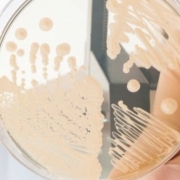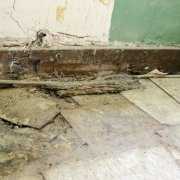Molds And Insurance
Molds occur naturally in almost all indoor environments. Mold spores may also enter a home through open doorways and windows, or heating, ventilation, and air conditioning systems. Most homeowners would benefit from a few helpful tips which might prevent or reduce the formation of molds in their home and keep any possible mold damage to a minimum. Most of these actions are easy to perform and can help significantly prevent the formation or spreading of mold growth.
Repair water leaks in your home or business immediately and mop or wipe dry any wet surfaces. Conduct a routine inspection of your property for water leaks and pay special attention to dishwashers, refrigerators, water heaters, kitchen sinks, attics, roofs and areas around windows. According to the National Centers for Disease Control, in most cases molds can be removed by a thorough cleaning with a solution of bleach and water.
In areas where home flooding has occurred, walls and other flood damaged items should be promptly cleaned. Insurers recommend that saturated carpet or furniture should be removed from one?s home but not discarded until an adjuster can properly assess the loss. Replace aging washing machine and icemaker hoses. The failure of washing machine hoses costs about $150 million in damage to homes each year in the U. S. and Canada. Try to maintain humidity levels in your home or business at low levels through the use of air conditioning or a dehumidifier. Buy a vacuum cleaner with a HEPA rated filter. These filters will filter out mold spores from the air as they vacuum. Keep the condensation pans in air conditioning and heating units clean and draining well. Be aware of the presence of odors that signify excessive moisture or mold growths. Molds and mildew often create an odor that is pungent and musty smelling, or “aromatic.” If you notice a musty smell in your house, contact a qualified inspector to determine the source.
Are molds something to be alarmed about? “No,” says Carol Johnson, an epidemiologist with the National Centers for Disease Control. Molds (fungi) are present everywhere – indoors and outdoors, in the air and on most common surfaces.
There are more than 100,000 known species of mold. At least 1,000 species of mold are common in the United States. Many molds are vital to our everyday life and are used in the production of everything from baked goods to penicillin.
However, the contamination of homes by mold infestations has recently been in the national news. Several multi-million dollar lawsuits against insurance companies, related to mold damage claims, indicate this issue is a major consideration for insurance carriers in the future.
The following points related to typical residential insurance coverage of mold damage and current scientifically based information on molds and health effects should be considered:
If a homeowner has a covered loss, insurers will provide an estimate of the cost of repair or replacement and make payments as outlined in the policy. An investigation of the claim may require calling upon experts to determine the cause, origin and toxicity of the mold. They may also be asked to recommend the appropriate repair method. Each claim will be handled according to its own unique facts and the terms and provisions of the insurance policy. If a covered mold loss makes a dwelling uninhabitable, or if an extended loss investigation and evaluation is required, additional living expenses may be provided to the resident as outlined in the insurance policy.
The cost of a single mold claim ranges from $10,000 to $100,000 for an investigation, additional living expenses and remediation, if necessary. Insurers estimate that anticipated claims resulting from mold contamination could result in at least a 30 to 40 percent increase in the cost of homeowners insurance in Texas. Depending on the amount of exposure, and a person’s individual susceptibility, health impacts – such as mild fevers and breathing problems can occur, but are very unusual. Many symptoms associated with mold exposure are common symptoms of other widespread illnesses such as colds, influenza, and other allergies. It is almost impossible to attribute these symptoms to just one cause.
Mold exposure typically does not present a health problem. However, some people may be sensitive to exposure to molds. Though not proven, certain individuals with chronic respiratory diseases (i.e. chronic obstructive pulmonary disorder, asthma, etc.) may claim to experience some discomfort or increased symptoms of their disorder from mold. Individuals with immune disorders may be at increased risk for sensitivity to a variety of environmental factors. There are very few reports that molds may produce toxic compounds (those containing certain mycotoxins) inside homes that claim cause unique or rare, health conditions such as pulmonary hemorrhage or memory loss. There are so few actual case studies to date, that a proven link between the presence of toxic mold in a home or building, and the extreme health conditions listed, has not been proven. Large mold infestations can usually be seen or smelled.
Stachybotrys chartarum and a related species Stachybotrys atra are known to produce mycotoxins under certain circumstances, and have received the most publicity related to claimed health impacts. Constant moisture is required for Stachybotrus and other molds to grow. Mold growing in homes and buildings, whether it is Stachybotrys chartarum (Stachybotrys atra) or other molds, almost always indicates that there is a water leak water or the presence of excessive moisture. The conditions allowing the mold (such as water leaks, excessive condensation, infiltration, or flooding) should first be repaired to prevent the mold from growing. Routine maintenance and common-sense repair measures taken by home and building owners will almost always prevent mold growth in the home and workplace. In most cases mold can be easily removed by a thorough cleaning with a solution of bleach and water. The U. S. National Center for Disease Control has stated that they do not believe that anyone needs to take any different precautions with Stachybotrys chartarum (Stachybotrys atra) than with preventing the growth of any other mold species. There is a surprising lack of scientific knowledge about the proven dangers that molds may present, and the many claims that are being made are the subject of great controversy. No scientific studies have been performed to date that establish a direct relationship between mold contamination and health impacts. As a result, no doctor or health official can establish what levels of mold are safe or unsafe in a home, school or office building. Currently there are no Federal regulations for evaluating potential health effects of fungal contamination and remediation. Any area with observed mold growth can easily be sampled by an environmental consultant. However the analysis to determine the species of mold present must be performed by a laboratory specializing in microbiology and these tests are very expensive – from hundreds to thousands of dollars. There is no simple and inexpensive way to sample the air in a home or building to find out what types of mold are present. Even if a dwelling is tested for mold, it is impossible to say at what levels health effects would occur. The most effective way to prevent and treat for mold contamination is to correct the underlying causes of the moisture that is present, which allows the mold to thrive.
Stachybotrys chartarum (Stachybotrys atra) are naturally occurring molds and are found nearly everywhere. At present there is no scientific test that has proven an association between Stachybotrys chartarum (Stachybotrys atra) and any particular health symptoms.
Among the many reasons excess mold forms are broken water lines, leaky plumbing and roofs, improperly vented bathrooms, and excessive humidity. Some of these causes may be covered by homeowner’s insurance policies and some are not. The terms of insurance coverage usually require that a sudden and accidental loss occur before claims under the policy are payable. The insured should contact his or her agent immediately in the event they believe they have experienced a loss, so that investigation and the necessary repairs can be made as soon as possible.
ADDITIONAL MESSAGE POINTS
In the courtrooms, homeowners, renters and office workers are squaring off against builders, contractors, and insurance companies in an attempt to assign blame to a problem that can cost tens, if not hundreds of thousands of dollars per building to repair. In some cases, the costs can reach into the millions, and they may exceed the value of the buildings themselves.
Like any other right or safeguard, the civil justice system can be abused and distorted in claims cases. Uncontrolled misuse of the court system will only lessen its value to consumers and impose hidden, unwarranted costs on everyone. It is in no one’s best interest when the civil justice system is distorted or used improperly. Litigation abuse will make needed insurance products and services much more costly, or even unavailable, to those who need them. The companies that provide these products or services must be allowed the opportunity to make a fair return on their investment without the unanticipated cost of excessive legal costs. In addition, opportunistic lawsuits cause the courts to be so clogged with needless cases that it may take years to get a fair hearing on a valid claim.
Mold is being compared to asbestos in terms of abatement and remediation costs. The big difference between the asbestos issue and the mold issue is the lack of scientific knowledge about the health effects, if any, of mold exposure. In addition there is no way to determine when people should abandon a mold-contaminated building. These decisions are currently being made by unlicensed mold “experts” and remediators.
Jack W. Snyder, M.D., Ph.D., M.P.H, in written testimony to the Texas Department of Insurance, stated that “the biomedical community requires a set of generally accepted criteria to be satisfied before reaching a conclusion that mold or any other agent in homes, schools, or offices has the capacity to cause objectively verifiable human illness,” and “the presence of mold in a room or office does not mean that mold has entered a person’s body or that mold has caused illness.” “Physicians and scientists do not validly or reliably reach diagnostic or causation conclusions when they simply attribute subjectively reported symptoms to the patient’s being in the vicinity of mold.” In addition, Dr. Snyder stated that “current speculation that the mold found in the nation’s homes, schools, and workplaces represents a significant public health problem cannot withstand even the most rudimentary medical and scientific scrutiny.”
Dr. Quade Stahl, the Director of the indoor air quality division of the Texas Department of Health said that there are over a thousand different mycotoxins that various molds produce and there is no way to determine the health effects on people and “it is impossible to set any type of standards.”
However, lawyers are increasingly winning excessively large mold damage claims by focusing not on the scientific issues of these cases but by portraying affected homeowners as helpless victims against large, well-financed, insurance corporations. Instead of arguing science, they blame insurance companies with allegations that they failed to promptly pay for or adequately repair a mold infestation. They blame the insurance companies for not acting quickly enough when no one can currently say how quickly is enough. They are also blaming builders and contractors for faulty building construction when in fact it is a maintenance or repair issue.
John Marlow of the AIA was quoted as saying “…mold-related lawsuits are forcing the industry to pay for the problem.” While it is still too early to say how much these claims cost the industry, Marlow said “the escalating numbers are bad news for everyone, especially consumers.”
IIABA’s Mold “White Paper” – The Insurance Implications of Toxic Mold Claims
One of the hottest issues facing the insurance industry today involves toxic mold claims under both personal and commercial lines policies. This article takes a look at the problem and coverage (or lack thereof) under standard homeowners, commercial property, general liability, and other commercial policies.


 www.moldfreeliving.com
www.moldfreeliving.com  The Meridian Start
The Meridian Start 



